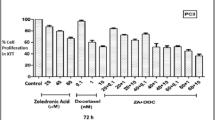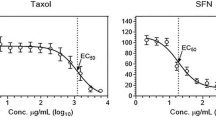Abstract
Background
The treatment of castrate-resistant prostate cancer (CRPC) still remains as an important challenge of daily oncology practice. Docetaxel significantly prolongs overall survival in men with CRPC. Thymoquinone (TQ), one of the flavonoid compounds isolated from Nigealla sativa, has been shown to possess cytotoxic activity against a variety of cancer cell lines.
Materials and Methods
The aim of the study was to investigate the possible synergistic cytotoxic/apoptotic effects of a novel combination, docetaxel and TQ in DU-145 hormone- and drug-refractory prostate cancer cells and their effects on PI3K and ERK signaling pathways.
Results
We observed that the combination of docetaxel and TQ resulted in a significant synergistic cytotoxicy and apoptosis as compared to any single agent alone, in a dose-dependent manner. It was found that viability of the combination treated cells was not significantly changed in the presence of LY294002 as compared to inhibitor treated cells. However, in the presence of FR180204, viability of combination treated cells was significantly decreased as compared to inhibitor treated cells. In conclusion, cytotoxic effect of the docetaxel and TQ combination is correlated with the block of the PI3K/Akt signaling pathway in DU-145 cells.
Conclusion
Therefore, this combination strategy may be an alternative approach for the challenging era of daily oncologic practice. Also, the combination of docetaxel and TQ might allow a reduction in docetaxel doses and diminish adverse effects of docetaxel while maintaining the therapeutic effect in patients with CRPC.






Similar content being viewed by others
References
Howlader N, Noone AM, Krapcho M, Neyman N, Aminou R, Waldron W et al. SEER cancer statistics review, 1975–2008. National Cancer Institute: Bethesda. http://seer.cancer.gov/csr/1975_2008/. Accessed 28 March 2013.
Hamberg P, Verhagen PC, de Wit R. When to start cytotoxic therapy inasymptomatic patients with hormone refractory prostate cancer? Eur J Cancer. 2008;44(9):1193–7.
Sternberg CN. Systemic chemotherapy and new experimental approaches in the treatment of metastatic prostate cancer. Ann Oncol. 2008;19(7):91–5. doi:10.1093/annonc/mdn473.
Petrylak DP, Tangen CM, Hussain MH, Lara PN Jr, Jones JA, Taplin ME, et al. Docetaxel and estramustine compared with mitoxantrone and prednisone for advanced refractory prostate cancer. N Engl J Med. 2004;351(15):1513–20.
Basch EM, Somerfield MR, Beer TM, Carducci MA, Higano CS, Hussain MH, et al. American Society of Clinical Oncology endorsement of the Cancer Care Ontario Practice Guideline on non hormonal therapy for men with metastatic hormone-refractory (castration resistant) prostate cancer. J Clin Oncol. 2007;25(33):5313–8.
Garmey EG, Sartor O, Halabi S, Vogelzang NJ. Second-line chemotherapy for advanced hormone-refractory prostate cancer. Clin Adv Hematol Oncol. 2008;6(2):118–32.
Picus J, Halabi S, Rini B. The use of bevacizumab with docetaxel and estramustine in hormone refractory prostate cancer: initial results of CALGB 90006. J Clin Oncol. 2003;22(Supp l):393 (Abstr 1578).
Salzberg M, Rochlitz C, Morant R, Thalmann G, Pedrazzini A, Roggero E, et al. An open-label, noncomparative phase II trial to evaluate the efficacy and safety of docetaxel in combination with gefitinib in patients with hormone-refractory metastatic prostate cancer. Onkologie. 2007;30(7):355–60.
Quinn DI, Tangen CM, Hussain M, Lara PN Jr, Goldkorn A, Moinpour CM, et al. Docetaxel and atrasentan versus docetaxel and placebo for men with advanced castration-resistant prostate cancer (SWOG S0421): a randomised phase 3 trial. Lancet Oncol. 2013;14(9):893–900. doi:10.1016/S1470-2045(13)70294-8.
Tannock IF, Fizazi K, Ivanov S, Karlsson CT, Fléchon A, Skoneczna I, et al. VENICE investigators. Aflibercept versus placebo in combination with docetaxel and prednisone for treatment of men with metastatic castration-resistant prostate cancer (VENICE): a phase 3, double-blind randomised trial. Lancet Oncol. 2013;14:760–8. doi:10.1016/S1470-2045(13)70184-0.
Hajhashemi V, Ghannadi A, Jafarabadi H. Black cumin seed essential oil, as a potent analgesic and antiinflammatory drug. Phytother Res. 2004;18(3):195–9.
Trang NT, Wanner MJ, le Phuong VN, Koomen GJ, Dung NX. Thymoquinone from Eupatorium ayapana. Planta Med. 1993;59(1):99.
Woo CC, Kumar AP, Sethi G, Tan KH. Thymoquinone:potential cure for inflammatory disorders and cancer. Biochem Pharmacol. 2012;83(4):443–51.
Koka PS, Mondal D, Schultz M, Abdel-Mageed AB, Agrawal KC. Studies on molecular mechanisms of growth inhibitory effects of thymoquinone against prostate cancer cells: role of reactive oxygen species. Exp Biol Med (Maywood). 2010;235(6):751–60.
Ross Richards L, Wilson F, Benghuzzi H, Tucci M. The role of estrogen, testosterone, and parathyroid hormones in combination with conventional and sustained antioxidant treatment on lncap cells-biomed 2009. Biomed Sci Instrum. 2009;45:268–73.
Wong KK, Engelman JA, Cantley LC. Targeting the PI3K signaling pathway in cancer. Curr Opin Genet Dev. 2010;20(1):87–90.
Carver BS, Chapinski C, Wongvipat J, Hieronymus H, Chen Y, Chandarlapaty S, et al. Reciprocal feedback regulation of PI3K and androgen receptor signaling in PTEN-deficient prostate cancer. Cancer Cell. 2011;19(5):575–86.
Maira SM, Pecchi S, Huang A, Burger M, Knapp M, Sterker D, et al. Identification and characterization of NVP-BKM120, an orally available pan-class I PI3-kinase inhibitor. Mol Cancer Ther. 2012;11(2):317–28.
Bueno OF, De Windt LJ, Tymitz KM, Witt SA, Kimball TR, Klevitsky R, et al. The MEK1-ERK1/2 signaling pathway promotes compensated cardiac hypertrophy intransgenic mice. EMBO J. 2000;19(23):6341–50.
Hong SK, Kim JH, Lin MF, Park JI. The Raf/MEK/extracellular signal-regulated kinase 1/2 pathway can mediate growth inhibitory and differentiation signaling via androgen receptor downregulation in prostate cancer cells. Exp Cell Res. 2011;317(18):2671–82.
Zubair H, Khan HY, Sohail A, Azim S, Ullah MF, Ahmad A, et al. Redox cycling of endogenous copper by thymoquinone leads to ROS-mediated DNA breakage and consequent cell death: putative anticancer mechanism of antioxidants. Cell Death Dis. 2013. doi:10.1038/cddis.2013.172.
Moon DO, Lee KJ, Choi YH, Kim GY. β-Sitosterol-induced -apoptosis in mediated by the activation of ERK and the downregulation of Akt in MCA-102 murine fibrosarcoma cells. Int Immunopharmacology. 2007;7(8):1044–53.
Kauffmann-Zeh A, Rodriguez-Viciana P, Ulrich E, Gilbert C, Coffer P, Downward J, et al. Suppression of c-Myc-induced apoptosis by Ras signalling through PI(3)K and PKB. Nature. 1997;385(6616):544–8.
Yoshimoto M, Cutz JC, Nuin PA, Gilbert C, Coffer P, Downward J, et al. Interphase FISH analysis of PTEN in histologic sections shows genomic deletions in 68% of primary prostate cancer and 23 % of high-grade prostatic intra-epithelial neoplasias. Cancer Genet Cytogenet. 2006;169(2):128–37.
Gray IC, Stewart LM, Phillips SM, Hamilton JA, Gray NE, Watson GJ, et al. Mutation and expression analysis of the putative prostate tumour-suppressor gene PTEN. Br J Cancer. 1998;78(10):1296–300.
Lamb LE, Knudsen BS, Miranti CK. E-cadherin-mediated survival of androgen-receptor-expressing secretory prostate epithelial cells derived from a stratified in vitro differentiation model. J Cell Sci. 2010;123(Pt2):266–76.
Agoulnik IU, Bingman WE 3rd, Nakka M, Li W, Wang Q, Liu XS, et al. Target gene specific regulation of androgen receptor activity by p42/p44 MAPK. Mol Endocrinol. 2008;22(11):2420–32.
Hong SK, Kim JH, Lin MF, Park JI. The Raf/MEK/extracelluler signal-regulated kinase 1/2 pathway can mediate growth inhibitory and differantion signaling via androgen receptor downregulation in prostate cancer cells. Exp Cell Res. 2011;317(18):2671–82.
Nomura T, Yamasaki M, Hirai K, Inoue T, Sato R, Matsuura K, et al. Targeting the Vav3 oncogene enhances docetaxel-induced apoptosis through the inhibition of androgen receptor phosphorylation in LNCaP prostate cancer cells under chronic hypoxia. Mol Cancer. 2013;12:27. doi:10.1186/1476-4598-12-27.
Qian DZ, Rademacher BL, Pittsenbarger J, Huang CY, Myrthue A, Higano CS, et al. CCL2 is induced by chemotherapy and protects prostate cancer cells from docetaxel-induced cytotoxicity. Prostate. 2010;70(4):433–42.
Randhawa MA, Alghamdi MS. Anticancer activity of Nigella sativa (black seed)—a review. Am J Chin Med. 2011;39(6):1075–91.
Shen R, Dorai T, Szaboles M, Katz AE, Olsson CA, Buttyan R. Transdifferentiation of cultured human prostate cancer cells to a neuroendocrine cell phenotype in a hormone-depleted medium. Urol Oncol. 1997;3(2):67–75.
Qiu Y, Robinson D, Pretlow TG, Kung HJ. Etk/Bmx, a tyrosine kinase with a pleckstrin-homology domain, is an effector of phosphatidylinositol 3′-kinase and is involved in interleukin 6-induced neuroendocrine differentiation of prostate cancer cells. Proc Natl Acad Sci USA. 1998;95(7):3644–9.
Abrahamsson PA. Neuroendocrine cells in tumour growth of the prostate. Endocr Relat Cancer. 1999;6(4):503–19.
Cohen RJ, Glezerson G, Haffejee Z. Neuro-endocrine cells—a new prognostic parameter in prostate cancer. Br J Urol. 1991;68(3):258–62.
Yuan TC, Veeramani S, Lin FF, Kondrikou D, Zelivianski S, Igawa T, et al. Androgen deprivation induces human prostate epithelial neuroendocrine differentiation of androgen-sensitive LNCaP cells. Endocr Relat Cancer. 2006;13(1):151–67.
Conflict of interest
The authors declare no conflict of interest.
Author information
Authors and Affiliations
Corresponding author
Rights and permissions
About this article
Cite this article
Dirican, A., Atmaca, H., Bozkurt, E. et al. Novel combination of docetaxel and thymoquinone induces synergistic cytotoxicity and apoptosis in DU-145 human prostate cancer cells by modulating PI3K–AKT pathway. Clin Transl Oncol 17, 145–151 (2015). https://doi.org/10.1007/s12094-014-1206-6
Received:
Accepted:
Published:
Issue Date:
DOI: https://doi.org/10.1007/s12094-014-1206-6




